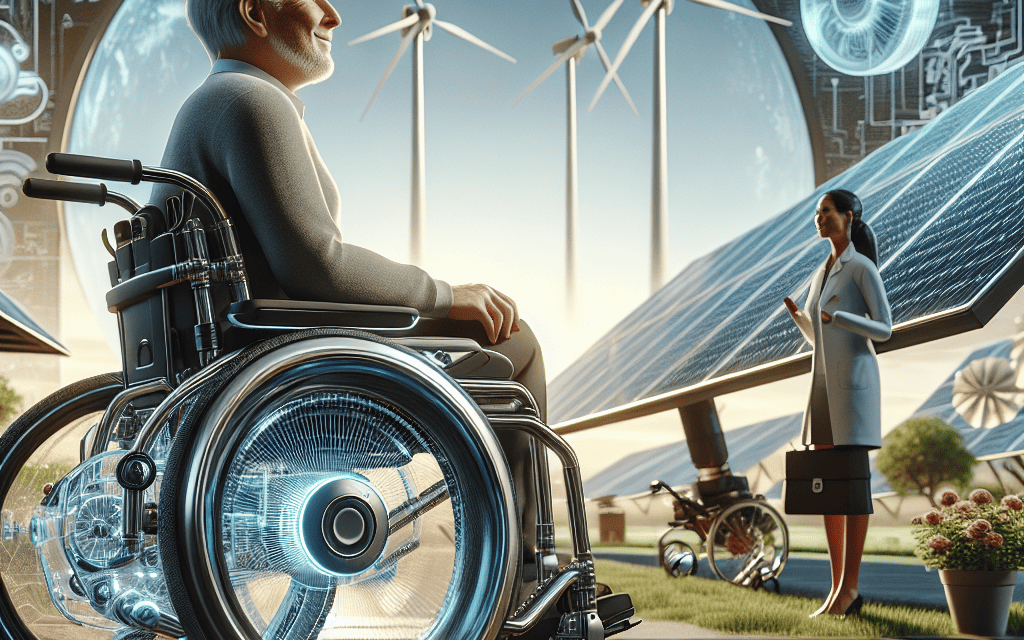Revolutionizing Mobility: Breakthrough Innovations in Electric Wheelchair Technology
The landscape of mobility aids has undergone a significant transformation in recent years, particularly with the advent of electric wheelchairs. These devices have evolved from simple mechanical constructs to sophisticated machines equipped with cutting-edge technology. This article delves into the breakthrough innovations in electric wheelchair technology, exploring five key subtopics: advancements in design and ergonomics, smart technology integration, battery and power management, enhanced mobility features, and the future of electric wheelchairs. Each section will provide insights into how these innovations are revolutionizing mobility for users worldwide.
Advancements in Design and Ergonomics
Design and ergonomics play a crucial role in the usability and comfort of electric wheelchairs. Modern innovations have focused on creating wheelchairs that not only meet functional needs but also enhance the user experience.
One of the most significant advancements in design is the shift towards customizable and modular systems. Manufacturers are now offering electric wheelchairs that can be tailored to the specific needs of the user. This includes adjustable seat heights, widths, and depths, as well as customizable armrests and footrests. Such flexibility ensures that users can find a configuration that maximizes comfort and minimizes the risk of pressure sores, which are a common concern for long-term wheelchair users.
Another notable trend is the incorporation of lightweight materials such as carbon fiber and aluminum. These materials not only reduce the overall weight of the wheelchair but also enhance durability and ease of transport. For instance, the use of carbon fiber in the frame can reduce weight by up to 50% compared to traditional steel frames, making it easier for users to maneuver and transport their wheelchairs.
Ergonomic design is also being prioritized, with many manufacturers focusing on creating chairs that promote better posture and support. Features such as contoured seating, lumbar support, and adjustable backrests are becoming standard. These enhancements are essential for users who spend extended periods in their wheelchairs, as they help to alleviate discomfort and prevent musculoskeletal issues.
Moreover, the aesthetic aspect of electric wheelchairs has not been overlooked. Manufacturers are increasingly offering a variety of colors and styles, allowing users to express their individuality. This shift towards more visually appealing designs helps to combat the stigma often associated with mobility aids, promoting a sense of pride and ownership among users.
Smart Technology Integration
The integration of smart technology into electric wheelchairs is one of the most exciting developments in recent years. These innovations are not only enhancing the functionality of wheelchairs but also improving the overall user experience.
One of the most significant advancements is the incorporation of IoT (Internet of Things) technology. Many modern electric wheelchairs are now equipped with sensors that can monitor various parameters, such as battery life, speed, and even the user’s posture. This data can be transmitted to a smartphone app, allowing users to track their usage patterns and receive alerts when maintenance is needed. For example, a wheelchair equipped with a smart battery management system can notify the user when the battery is running low, ensuring they are never caught off guard.
Additionally, smart technology has enabled the development of advanced navigation systems. Some electric wheelchairs now come with GPS capabilities, allowing users to map out routes and receive real-time navigation assistance. This feature is particularly beneficial for users who may be unfamiliar with their surroundings or who wish to explore new areas independently. For instance, the WHILL Model Ci is equipped with a smart navigation system that can help users navigate through crowded spaces with ease.
Voice-activated controls are another innovative feature being integrated into electric wheelchairs. This technology allows users to control their wheelchairs using simple voice commands, making it easier for those with limited dexterity to operate their devices. For example, the Permobil F5 Corpus VS wheelchair offers voice control options that enable users to adjust their seating position or speed without needing to use their hands.
Furthermore, the integration of artificial intelligence (AI) is paving the way for even more advanced functionalities. AI can analyze user behavior and preferences, allowing the wheelchair to adapt to the user’s needs over time. For instance, some models can learn the user’s preferred routes and automatically adjust settings for optimal performance based on past usage.
Battery and Power Management
Battery technology is a critical component of electric wheelchairs, directly impacting their performance, range, and overall user satisfaction. Recent advancements in battery and power management systems have significantly improved the functionality of electric wheelchairs.
One of the most notable innovations is the development of lithium-ion batteries, which have largely replaced traditional lead-acid batteries in modern electric wheelchairs. Lithium-ion batteries are lighter, more efficient, and have a longer lifespan compared to their lead-acid counterparts. For example, a lithium-ion battery can provide up to 30% more range on a single charge, allowing users to travel longer distances without worrying about running out of power.
Moreover, advancements in battery management systems (BMS) have enhanced the safety and reliability of electric wheelchairs. A BMS monitors the battery’s health, ensuring it operates within safe parameters and preventing issues such as overcharging or overheating. This technology not only extends the battery’s lifespan but also provides users with peace of mind regarding their wheelchair’s performance.
Charging technology has also seen significant improvements. Many modern electric wheelchairs now feature fast-charging capabilities, allowing users to recharge their batteries in a fraction of the time it would take with traditional chargers. For instance, some models can achieve an 80% charge in just one hour, making it more convenient for users who need to recharge quickly between outings.
Additionally, regenerative braking systems are being integrated into electric wheelchairs, allowing users to harness energy during braking and use it to recharge the battery. This feature not only extends the range of the wheelchair but also promotes energy efficiency, making electric wheelchairs more sustainable options for mobility.
Enhanced Mobility Features
Enhanced mobility features are at the forefront of electric wheelchair innovation, providing users with greater independence and versatility. These features are designed to improve maneuverability, accessibility, and overall user experience.
One of the most significant advancements is the development of all-terrain electric wheelchairs. These models are equipped with robust wheels and suspension systems that allow users to navigate various terrains, from gravel paths to grassy fields. For example, the Action Trackchair is designed specifically for outdoor use, enabling users to explore nature and participate in outdoor activities that were previously inaccessible.
Another innovative feature is the introduction of standing wheelchairs, which allow users to transition from a seated to a standing position. This capability not only enhances mobility but also provides numerous health benefits, including improved circulation, reduced pressure sores, and enhanced social interaction. The Permobil F5 Corpus VS is a prime example of a standing wheelchair that offers users the ability to stand at the push of a button.
Smart control systems are also revolutionizing how users interact with their electric wheelchairs. Many models now feature joystick controls that can be customized to suit individual preferences, including sensitivity settings and control layouts. Some advanced models even offer head or eye-tracking controls, allowing users with limited hand function to operate their wheelchairs with ease.
Moreover, the integration of obstacle detection systems is enhancing safety for users. These systems use sensors to detect obstacles in the wheelchair’s path and can automatically adjust the speed or direction to prevent collisions. This feature is particularly beneficial for users navigating crowded or unfamiliar environments.
The Future of Electric Wheelchairs
The future of electric wheelchairs is bright, with ongoing research and development promising even more groundbreaking innovations. As technology continues to advance, we can expect to see several trends shaping the next generation of electric wheelchairs.
One of the most exciting prospects is the potential for autonomous electric wheelchairs. Researchers are exploring the use of AI and machine learning to develop wheelchairs that can navigate independently, allowing users to focus on their surroundings rather than controlling the device. This technology could significantly enhance mobility for individuals with severe disabilities, providing them with newfound independence.
Additionally, advancements in materials science may lead to the development of even lighter and more durable wheelchair frames. Innovations such as 3D printing could allow for custom-designed components that are tailored to individual users, further enhancing comfort and usability.
Another area of focus is the integration of renewable energy sources into electric wheelchairs. Solar panels could be incorporated into the design, allowing users to harness solar energy to recharge their batteries while on the go. This would not only extend the range of electric wheelchairs but also promote sustainability in mobility solutions.
Furthermore, as telehealth becomes more prevalent, we may see electric wheelchairs equipped with telemedicine capabilities. This would allow users to connect with healthcare professionals remotely, enabling them to receive guidance on wheelchair adjustments or health monitoring without needing to leave their homes.
Conclusion
The innovations in electric wheelchair technology are revolutionizing mobility for individuals with disabilities, providing them with greater independence, comfort, and accessibility. From advancements in design and ergonomics to the integration of smart technology and enhanced mobility features, the landscape of electric wheelchairs is evolving rapidly.
As we look to the future, the potential for autonomous navigation, renewable energy integration, and telehealth capabilities promises to further enhance the user experience. These breakthroughs not only improve the quality of life for wheelchair users but also challenge societal perceptions of mobility aids, promoting inclusivity and empowerment.
In summary, the ongoing advancements in electric wheelchair technology are paving the way for a more accessible and inclusive world, where individuals with mobility challenges can navigate their environments with confidence and ease.





